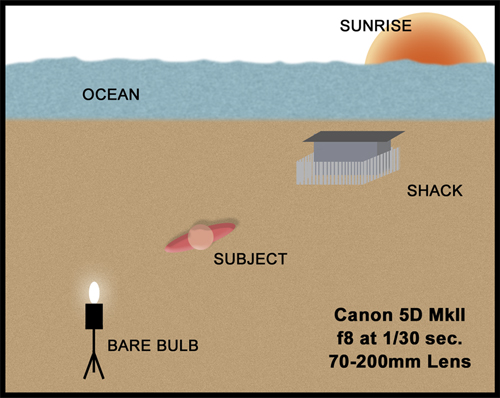by
Gregory Daniel, M.Photog. CR., F-ASP
It seems like 100 years ago when I was fortunate enough to take Don Blair’s class. He was a brilliant instructor, mentor and master of light.
I remember so many wonderful nuggets of information from his class. He shared his knowledge so freely and quickly filled my toolbox with skills I use daily. I think of Don often along with many of the other dedicated instructors who are responsible for my toolbox.
Don was constantly ready to shoot images and was on the lookout for every opportunity to make magic. Inspired by a small mound outside our hotel room and the beautiful sunrise each day, Don insisted Lesa and I model for him at the break of dawn and assured the entire class they would not be disappointed in the adventure. Of course, we all agreed and were eager to see how he was going to pull off such a difficult lighting situation. True to his word, this adventure proved to be a lesson I have pulled from many times. He posed us atop a small mound and stepped into the dark side aiming his Hasselblad camera into the rising sun.
Don pointed out that the strong backlight would create a lovely kiss of light around us giving us visual separation from the background. I thought that appeared a bit strange and could only imagine the camera recording a silhouette. We all questioned how could you get enough light on the subject so the shadows would not be extreme.
Don reached into his bag and pulled out a Lumedyne strobe and proceeded to pull off the reflector (who knew that thing was removable), and described the “Bare Bulb” sweet light. Explaining how the bulbs power released from the sides so the bulb side should face the subject. Placing the bulb in this direction would create a large wall of light illuminating with a sweet spread dancing throughout the scene and not tunneling directly on the subject. Shadows would be softer, and the lighting will look more natural.
 He placed the strobe 10 feet away, about 60 degrees off camera axis setting the power to 100 ws. Using his light meter set on flash he measured the light to read f-8 with ISO 400 (now ISO). Now he said it all pivots from the f-8. We must now find out which shutter speed will give us a natural looking sky with f-8 locked in place. On this day, 30th of second was perfect although a tripod was required to hold the camera steady. For extra measure he locked the mirror up to reduce any camera vibration during the exposure.
He placed the strobe 10 feet away, about 60 degrees off camera axis setting the power to 100 ws. Using his light meter set on flash he measured the light to read f-8 with ISO 400 (now ISO). Now he said it all pivots from the f-8. We must now find out which shutter speed will give us a natural looking sky with f-8 locked in place. On this day, 30th of second was perfect although a tripod was required to hold the camera steady. For extra measure he locked the mirror up to reduce any camera vibration during the exposure.
The example I am sharing was created for a lovely client that commissioned us to design a portrait showing her daughter’s personality and interests. She loves being a lifeguard while still in college. You can see the lifeguard shack where meetings are held each morning. As we arrived on location early in the morning, I immediately thought of Don’s Bare Bulb lesson from many years ago and confidently reached into my toolbox to create this lovely treasure.
 I am continually amazed and thankful to all my past mentors that helped me fill my toolbox full of valuable photographic knowledge. All the hours I spent studying with dedicated individuals willing to give their time and share priceless nuggets of information pay off daily. Thanks to Professional Photographers of America, all the Affiliates and instructors for continually striving to provide quality education to each and everyone who is willing to partake.
I am continually amazed and thankful to all my past mentors that helped me fill my toolbox full of valuable photographic knowledge. All the hours I spent studying with dedicated individuals willing to give their time and share priceless nuggets of information pay off daily. Thanks to Professional Photographers of America, all the Affiliates and instructors for continually striving to provide quality education to each and everyone who is willing to partake.











